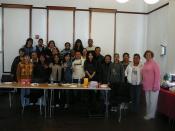Background of ESL
English as a Second Language (ESL) began as a program to assist Limited English Proficient (LEP) students. Our nation's schools are comprised of a diverse student body. Each student enters school at a different starting point of knowledge due to their cultural, social, ethnic, or economical background. 42 percent of all public teachers have at least one LEP student in their class. To ignore students that come in with no English speaking ability is a violation of their civil rights.
In the 1970s, Chinese-American students in a San Francisco school district were placed in classrooms where everything was taught in English. The problem was that these Chinese-American students were deficient in English and assistance was not provided by the schools. Many of these students began to drop out and join gangs due to their frustrations. A lawsuit was filed against the San Francisco School Board saying that the Chinese American students were denied the opportunity to participate in the classrooms due to their English deficiency.
They argued that this violated their civil right based on their cultural and ethnic background. In 1974, the U.S. Supreme Court ruled that LEP students must receive instruction tailored to their needs. In the end, the San Francisco schools agreed to provide bilingual education for Chinese, Filipino, and Hispanic children.
ESL instruction uses techniques to help language minority students with the English language. It is a separate course where the primary focus is to aid English deficient students with English. This differs from bilingual education in that bilingual education teaches courses in the minority language student's native language. Of all the schools that have LEP students, 76 percent offer ESL and 36 percent offer bilingual education programs. Since there are more than ten times as many Spanish speaking students then the next...

